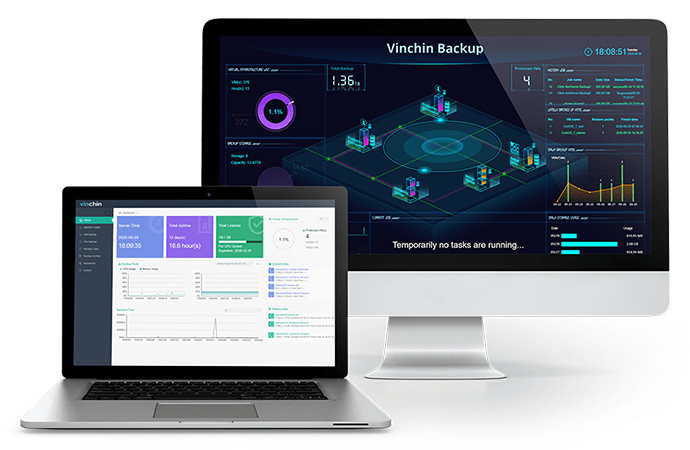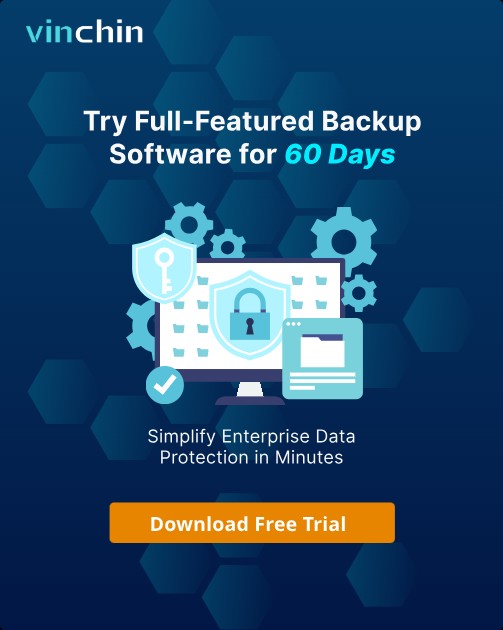-
The importance of Linux backup
-
How to choose reliable Linux backup software?
-
Top 15 Linux Backup software 2025
-
Linux backup software FAQs
-
Conclusion
Backups save your data from sudden loss. They protect against hardware failure, accidental deletion, ransomware, and more. Many Linux users rely on built-in commands like tar or rsync, but modern needs demand automated, encrypted, and incremental backups.
A good backup plan follows the 3-2-1 rule: keep three copies of your data, on two different media, with one off-site . For server environments, this means combining full and incremental backups, snapshot techniques, and off-site backup.
Command-line aficionados favor tools like BorgBackup for deduplication and encryption, while desktop users may choose GUI-driven apps like Deja Dup.
Commercial offerings bring enterprise features such as hypervisor integration, centralized management, and support contracts. Vinchin Backup & Recovery, for example, secures Linux servers with agent-based snapshots and AES-256 encryption both in transit and at rest. Veeam Agent for Linux extends Veeam's popular platform to Linux workloads, offering SureBackup verification and cloud tiering.
In this guide, you'll learn why Linux backups are critical, what criteria ensure reliability, and which 15 solutions stand out in 2025. Each tool's key features are highlighted to help you choose the right fit for desktops, servers, or cloud environments.
The importance of Linux backup
Reliable backups are a safety net for your data. Even the most stable Linux server can suffer disk failures or file corruption.
Backups also defend against human errors. A simple rm command can erase critical files. Having a recent snapshot lets you restore without downtime.
Security threats like ransomware target unprotected data. Encrypted backups, stored off-site, ensure you can recover without paying a ransom.
Finally, backups support compliance. Industries often mandate data retention and disaster-recovery plans. Automated backups with audit logs satisfy many regulatory requirements.
How to choose reliable Linux backup software?
Picking the right software requires clear criteria:
Ease of use
GUI or CLI? Desktop users may prefer point-and-click interfaces like Deja Dup.
Server admins often favor scripts and cron jobs with tools like rsync or r-diff-backup.
Performance and efficiency
Deduplication reduces storage needs; tools like BorgBackup excel here.
Incremental backups save time and bandwidth.
Security
Encryption in transit and at rest is essential; look for AES-256 support.
Authentication and access controls protect backup data.
Scalability and integration
For virtual environments, hypervisor integration is key. Vinchin supports VMware, Hyper-V, KVM-based hypervisors like Proxmox, oVirt, OLVM and more.
Cloud compatibility lets you archive older backups to S3, Azure, or Google Cloud .
Recovery options
Instant VM recovery, bare-metal restore, and granular file restores reduce downtime.
Test your restore process regularly.
Support and community
Commercial products offer SLAs and support contracts.
Open-source tools thrive on active communities and regular releases.
Top 15 Linux Backup software 2025
1. Vinchin Backup & Recovery
Vinchin Backup & Recovery provides a single pane of glass for physical, virtual, and cloud backups. It uses both agentless (for virtual machines and cloud instances) and agent-based (for physical servers and databases) methods to capture entire systems or select data sets. AES-256 encryption in transit and at rest keeps backups secure, while block-level deduplication and compression cut storage needs. An intuitive web console automates scheduling, monitoring, and alerting. Off-site replication and an integrated recovery lab ensure rapid failover. Backed by 24/7 support, it scales from small shops to large enterprises.

Supported Distros: RHEL, CentOS, Ubuntu, Debian, SUSE , Oracle, Rocky
Deduplication & Compression: Block-level dedupe plus inline compression
Encryption: AES-256 for data in transit and at rest
Automation & Monitoring: Web console for job scheduling, alerts, dashboards
Disaster Recovery: Off-site copy; instant VM failover lab
2. BorgBackup
BorgBackup is a CLI archiver focused on efficiency and security. It splits data into content-defined chunks to eliminate redundancy, compresses using lz4, zstd, zlib, or lzma, and secures archives with AES-256/HMAC-SHA256. Mountable via FUSE, backups behave like local mounts for easy browsing. Users script it via cron for incremental, deduplicated snapshots. Its BSD license and active community ensure ongoing improvements.
Supported Distros: Alpine, Arch, Debian, Fedora/RHEL, Gentoo, openSUSE, Ubuntu, FreeBSD
Deduplication: Content-defined chunking removes duplicate blocks
Authenticated Encryption: AES-256 with HMAC-SHA256
Compression Options: lz4, zstd, zlib, lzma
Mountable Archives: Access backups via FUSE
3. Restic
Restic is a Go-based backup program that balances speed, security, and simplicity. It encrypts all data with AES-256, deduplicates at blob level, and ships in a single static binary. Restic writes to many backends—S3, Azure, Google Cloud, Backblaze B2, SFTP, WebDAV—so it fits both on-prem and cloud workflows. Its plain-text configuration and CLI make it easy to automate via cron. The project's BSD-2-Clause license and active development ensure reliability.
Supported Distros: Ubuntu, Debian, RHEL/CentOS, Fedora, Arch
Blob Deduplication: Only new data segments are stored
AES-256 Encryption: Secure all snapshots end-to-end
Multi-Backend: S3, Azure, GCP, B2, SFTP, WebDAV
Single Binary: No dependencies, easy deploy on servers
4. Duplicati
Duplicati offers encrypted, incremental backups via a responsive web UI. Built on .NET/Mono, it supports Debian- and Red Hat-based distros with native .deb and .rpm packages. Backups are protected by AES-256, compressed by ZIP, and can target 20+ backends—S3, OneDrive, Google Drive, FTP, WebDAV, SFTP. Scheduling, retention policies, and backup verification guard data integrity. Suited for desktops and small servers.
Supported Distros: Ubuntu, Mint, Fedora, SUSE (others via Mono)
Web UI: Browser-based job creation and monitoring
AES-256 Encryption: End-to-end secure backups
Incremental & Compressed: Saves time and space
20+ Backends: S3, OneDrive, Google Drive, FTP, WebDAV, SFTP
5. Deja Dup
Deja Dup is GNOME's simple frontend to Duplicity. It uses GPG for encryption and stores incremental, compressed archives locally or on Google Drive. A wizard guides users through folder selection, schedule, and retention. Restores are one-click. Ideal for desktop users seeking set-and-forget file backups without command-line complexity.
Supported Distros: Ubuntu, Fedora, Debian, any GNOME-based distro
GPG Encryption: Secure archives via GnuPG
Incremental: Only changed files are backed up
Cloud Support: Google Drive integration
Wizard UI: Guided setup and restore
6. Timeshift
Timeshift snapshots system files and settings for fast rollback. Using rsync and hard links, it takes hourly, daily, and weekly snapshots, excluding user data by default. A live USB lets you restore the OS after broken updates or misconfiguration. It's not for home directories but excels at system recovery.
Rsync & Hard Links: Efficient, incremental snapshots
Scheduled Snapshots: Hourly, daily, weekly
System-Only: Excludes /home by default
Live Restore: Recover via bootable USB
Supported Distros: Ubuntu, Linux Mint, Fedora, openSUSE, Debian
7. rsync
rsync is the workhorse for file-level sync and backups. It sends only changed blocks, secures transfers over SSH, and allows include/exclude patterns. Administrators script it via cron or wrap it in front-ends like rsnapshot. Versatile for local or remote backups.
Supported Distros: Available on virtually all Linux distributions
Delta Transfer: Transfers only modified data
SSH Transport: Secure remote backups
Filters: Fine-grained include/exclude rules
Cron Integration: Automate with scripts
8. Duplicacy
Duplicacy features lock-free global deduplication, letting multiple clients back up to the same storage repository in parallel. Both CLI and GUI clients support S3, Google Drive, Backblaze B2, SFTP, and WebDAV. It emphasizes data safety and efficiency in distributed teams.
Supported Distros: Debian, Ubuntu, Fedora, RHEL, CentOS, Arch
Global Deduplication: Single copy across devices
Lock-Free: Concurrent backups without repo locks
Cross-Platform: CLI and Electron GUI
20+ Backends: S3, GDrive, B2, SFTP, WebDAV
9. Amanda
Amanda (Advanced Maryland Automatic Network Disk Archiver) is a client-server solution for enterprise environments. A master server schedules jobs; agents push data over TCP to disks, tapes, or cloud. It scales to hundreds of hosts, supports policy-based retention, and has community and enterprise editions with GUI and SLA support.
Supported Distros: RHEL/CentOS, Ubuntu, Debian, SUSE, Solaris
Client-Server: Central master controls backups
Tape & Disk: Native tape library and disk staging
Cloud Plugins: S3, Azure, Google Cloud via add-ons
Policy-Driven: Custom schedules and retention
10. Bacula
Bacula is a modular, enterprise backup suite with director, storage, file, and catalog daemons. It supports disk, tape, NDMP, and cloud targets. TLS encryption, CRAM-MD5 authentication, and policy-driven schedules ensure security and flexibility. Community and commercial editions include web GUIs and enterprise support.
Supported Distros: RHEL/CentOS, Ubuntu, Debian, SUSE, Fedora
Modular Architecture: Separate daemons for control, storage, file, catalog
Multi-Media: Disk, tape, NDMP, cloud backends
Secure Communication: TLS, CRAM-MD5 auth
Policy Scheduling: Full, incremental, differential jobs
11. UrBackup
UrBackup is an open-source client-server system combining continuous file backups with periodic image snapshots. It detects changes in real time, offers bare-metal recovery via boot media, and features a web UI for monitoring and restore. Agents run on Linux, Windows, and macOS.
Supported Distros: Debian, Ubuntu, RHEL/CentOS, Fedora, SUSE
Image & File Mode: Block-level images plus file backups
Continuous Monitoring: Instant detection of changes
Bare-Metal Restore: Bootable USB recovery
Web Interface: Manage and restore in browser
12. Veeam Agent for Linux
Veeam Agent for Linux extends Veeam's platform to endpoints and servers. It uses a Linux snapshot driver and Changed Block Tracking for efficient incremental jobs. Backups can target local disks, shares, object storage, or Veeam Backup & Replication repositories. Bare-metal, volume-level, and file-level restores are supported, along with a bootable recovery media builder.
Supported Distros: Ubuntu, Debian, RHEL, CentO
Snapshot & CBT: Fast incremental backups
Image & File: Full system or selective backups
Flexible Targets: Local, network share, S3, VBR repo
Recovery Options: Bare-metal, volume, file restore
13. Acronis Cyber Protect for Linux
Acronis Cyber Protect unifies backup with AI-driven anti-malware. It creates image-based snapshots, offers continuous data protection, and integrates cloud-tiering to Acronis Cloud. Real-time I/O monitoring blocks ransomware from altering backups. Flexible restores cover bare-metal, file-level, and partition recoveries.
Supported Distros: Any Linux with kernel 2.6.9-5.14 and glibc ≥2.3.4 (Ubuntu, RHEL, CentOS, SUSE)
Image Snapshots: Full system captures
AI Anti-Ransomware: Real-time threat blocking
Cloud Tiering: Archive to Acronis Cloud
Encrypted Transfers: AES-256 in transit and at rest
14. Clonezilla
Clonezilla is a live ISO/USB tool for disk and partition imaging. It captures block-level images, optionally compresses with gzip or lzo, and supports encryption. The SE (server) variant can multicast to deploy images to many machines simultaneously. Covers nearly all filesystems and OSes.
Filesystem Support: ext, NTFS, FAT, XFS, Btrfs, HFS+
Block Imaging: Full disk/partition clones
Compression & Encryption: gzip/lzo plus optional cipher
Multicast: SE for mass deployment
Filesystem Support: ext, NTFS, FAT, XFS, Btrfs, HFS+
15. Mondo Rescue
Mondo Rescue creates bootable ISOs for bare-metal restores. It supports tape spanning, disk, NFS, and SSH targets. Multi-filesystem and LVM support let you back up complex layouts. Designed for complete disaster recovery in enterprise Linux environments.
Bootable ISO: Live media recovery
Tape & Disk: Native spanning and disk backup
Multi-FS & LVM: ext, XFS, ReiserFS, JFS, LVM
Network Targets: NFS, SSH
Supported Distros: RHEL/CentOS 6-8, Ubuntu 14-22, Debian 8-12, SUSE 12-15
Linux backup software FAQs
Q1: What is Linux backup software?
A: Linux backup software automates the copying of files, folders, or entire systems to another location for safekeeping. It can handle simple file copies or full system images, ensuring you can recover data after hardware failure, accidental deletion, or security breaches.
Q2: What backup methods are available on Linux?
A: There are three main methods: full, incremental, and differential backups .
Full backup saves all selected data each time.
Incremental backup saves only data changed since the last backup.
Differential backup saves data changed since the last full backup
Q3: How do I verify backup integrity?
Best practice is to perform periodic test restores. You can also plant a “sentinel” file in your data set and attempt to restore it regularly. With Vinchin file level restore, you can test restoring that file quickly.
Conclusion
Reliable backups are essential for Linux systems to protect against hardware failures, accidental deletions, and security threats like ransomware. Choosing dependable backup software involves evaluating ease of use, performance and storage efficiency through deduplication and compression, robust security with encryption, and seamless scalability for virtual and cloud environments.
In 2025, both open-source tools and commercial solutions (such as Vinchin Backup & Recovery) offer varied feature sets for desktop, server, and enterprise needs.
Share on:








